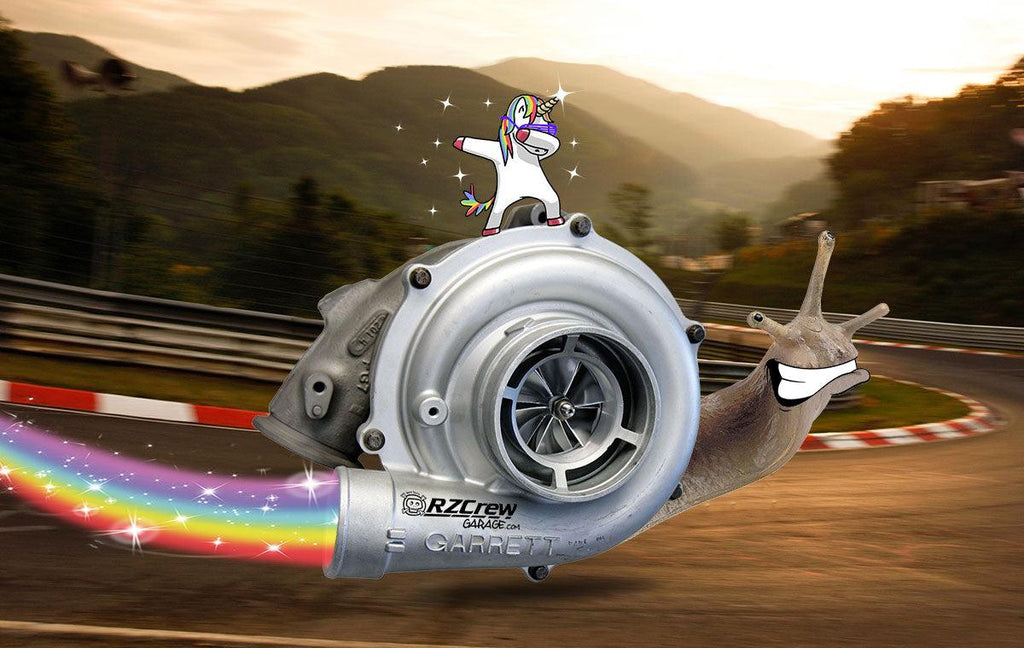How to Choose Your Turbo: The Rzcrew turbo map tool!

If you are looking at turbos and wondering:
- What turbos are available for my needs?
- How to find the best turbo for my engine?
- How to avoid turbo surge or turbo lag?
Then this article is for you!

There are three well know facts about turbos:
- They look like snails
- They use magic or unicorn power (depending on your religion)
- Most importantly, they make POWER
But aside from the mystical properties of turbos, there is actually some science and physics behind them.
Whether you are upgrading your turbo or building a powerhouse from an NA mill, choosing the right weapon for your use is critical, and this is why the RZCrew Academy has come up with a magic excel file to help you find the best turbocharger for your needs.
How turbos work in 2 lines:
Turbos use exhaust gases to spin a turbine. This turbine compresses air coming in the engine, and this dense air, once mixed with fuel in the combustion chamber, creates a much stronger explosion, and more power.

There are armies of turbos out there, and before you slap one on your engine, it is important to know which one will be the best one for your needs. This depends on a lot of factors such as the type of engine, displacement, max RPM, whether you are running an intercooler or not, and others such as atmospheric pressure and intake air temp.
These factors, once computed, result in two main parameters: Corrected Airflow and Pressure Ratio. Comparing those two values against a turbo map allows you to find the right turbo size for your needs and avoid turbo surge or huge lag which will make your usage of the turbo difficult or useless.
Each turbo has its own turbo map, to illustrate how to read them and the differences between turbos, here is a comparison between Garrett's GT2860R, GT2860RS and the new generation GTX2860R.

All three turbo maps are at the same scale, and you can see right off the bat the differences between each one. Here's how to read them:
- On the left of the islands, you have the surge line (the red zone). Operating in this zone causes compressor surge, which is when the air pressure after the compressor is higher than what the turbo is designed to physically maintain. This causes the airflow in the compressor wheel to back up, build pressure, and sometimes stall. In extreme cases, the thrust bearings of the turbo can be destroyed.
Surge happens when the turbo is too big for the application, when the plumbing for the blowoff valve is too small or restrictive, or when there is no blowoff valve between the turbo and the throttle body.
- On the right of the islands is the choke line (the blue zone). This represents the point after which the turbo efficiency drops below 58%.
Choke happens when the turbo is too small and the turbine exceeds its designed max rpm.
- In light green is the 70% efficiency zone, and in darker green the max efficiency zone of each turbo. These are the zones in which you want your Pressure Ratio and Corrected Airflow to meet. In this example, you can clearly see the evolution of the 2860 line of turbos, with the Gen2 being able to reach a much higher absolute boost, and a much wider max efficiency zone than its predecessors.
To help you finding the right turbo, the RZCrew Academy has devised an excel calculation sheet which will tell you which are the best turbos for your needs.
Here's how it works:

Step 1/ Enter your engine infos in the green boxes.
The mandatory fields are Engine capacity, Max engine RPM, Targeted boost and whether you use an intercooler or not (1=yes, 0=no).
If you are not sure about the rest of the infos (atmospheric pressure, etc.) do not touch them. They are set at a standard average.
Step 2/ Find the turbos that fit your needs in the blue zone
Step 3/ Read the notes and recommendations linked to each turbo based on your specific application
Step 4/ Follow the link to the store to order your turbo! :D
To illustrate how to read all this, we'll use the GT2860 maps from above and make some calculations.
The engine we'll take is a 1.8L redlining at 7,300rpm with FMIC installed.
We will test it with 3 boost limits:
15PSI (Corrected airflow: 26.507, Pressure Ratio 2.0915) - blue line
20PSI (Corrected airflow: 30.97, Pressure Ratio 2.4437) - yellow line
25PSI (Corrected airflow: 35.432, Pressure Ratio 2.7958) - red line

You can see here that at 15PSI, all 3 turbos will be running at max efficiency and will fit your application.
At 20 PSI, we see that the GT2860R and GT2860RS will match, yet not at full efficiency, while the GTX2860 Gen2 is still well within the optimum range.
At 25 PSI, the GT2860R will be borderline choking, the GT2860RS will be unable to provide boost, and the GTX2860 Gen2 will still be within 70% efficiency.
In the results on the calculator, you will see first the most optimized turbos for your use, and below selections marked "!". These last options consider +/-20% of the engine displacement. This allows to see that some turbo applications, even if not ideal for daily driving, are still an option (like a bigger turbo for drag applications). These will have notes on the right with advice about what additional mods or parts to consider when choosing those turbos.
We hope this helps you find your dream turbo!
- Benjamin Attard